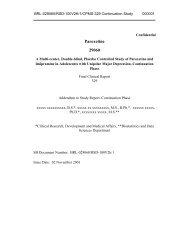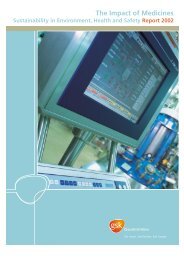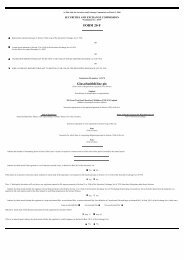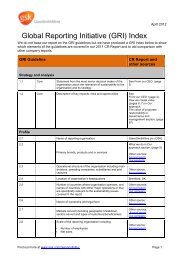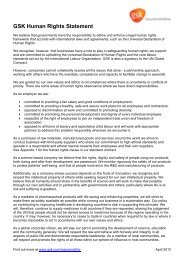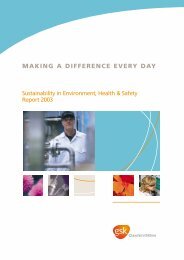GSK Annual Report 2002
GSK Annual Report 2002
GSK Annual Report 2002
Create successful ePaper yourself
Turn your PDF publications into a flip-book with our unique Google optimized e-Paper software.
Product approvals<br />
Country/Region<br />
Product (Approval Date) Description<br />
Description of business GlaxoSmithKline 19<br />
In <strong>2002</strong>, approvals were received for a number of new products, including several significant new indications and formulations for existing<br />
products, as summarised in the table below.<br />
Augmentin XR USA (October) extended release formulation of amoxicillin (a beta-lactam antibiotic)<br />
and clavulanate (a beta lactamase inhibitor) for adult respiratory tract<br />
infections<br />
Avandamet USA (October) fixed dose combination of Avandia and metformin for type 2 diabetes<br />
Avodart USA (October) 2 year data on dutasteride, a 5-alpha reductase inhibitor for the<br />
treatment of benign prostatic hypertrophy (BPH)<br />
Avodart Europe (July) dutasteride, for the treatment of BPH<br />
Epivir USA (October) once daily dosing with lamivudine, a reverse transcriptase inhibitor, for<br />
HIV<br />
Flixotide Europe (October) lower age limit for fluticasone, an inhaled corticosteroid for asthma<br />
Flonase USA (May) intranasal fluticasone for nasal symptoms<br />
Flutide Japan (October) fluticasone in a CFC-free inhaler<br />
Lotronex USA (June) reintroduction of alosetron for irritable bowel syndrome (IBS)<br />
Paxil CR USA (February) paroxetine, a selective serotonin re-uptake inhibitor for panic disorder<br />
Pediarix USA (December) combined diphtheria, tetanus, pertussis, hepatitis B and polio vaccine<br />
for children<br />
Serevent Diskus USA (March) dry powder formulation of salmeterol (a long-acting beta blocker) for<br />
COPD<br />
Serevent MDI and Diskus Japan (April) salmeterol in both metered dose and dry powder inhalers for asthma<br />
Sultanol Diskus Japan (March) the short-acting beta blocker salbutamol in a dry powder device for<br />
asthma<br />
Twinrix 2 dose Europe (September) combined vaccine for hepatitis A and B<br />
Valtrex USA (September) valaciclovir, a DNA polymerase inhibitor for the treatment of cold sores<br />
Wellbutrin SR USA (June) additional strength of bupropion for depression<br />
Zovirax cream USA (December) aciclovir, a DNA polymerase inhibitor for the treatment of cold sores<br />
Zyloric tablets Japan (March) allopurinol, a xanthine-oxidase inhibitor, for the treatment of gout<br />
R&D Processes – Discovery, Commercialisation & Delivery<br />
Genetics<br />
Research<br />
Discovery<br />
Research<br />
Intellectual property<br />
validated targets<br />
and leads<br />
Centres<br />
of Excellence<br />
for Drug Discovery<br />
"CEDDs"<br />
Pre-clinical<br />
Development<br />
New Product<br />
Development<br />
Drugs Products<br />
New<br />
Medicines<br />
of Proven<br />
Value<br />
R&D processes<br />
In line with GlaxoSmithKline's strategic intent to become the<br />
indisputable leader in the industry, R&D has set itself the goal of<br />
becoming the industry’s most productive R&D organisation. Steps<br />
to achieve this have included initiatives to both reduce the time<br />
taken in all phases of the discovery and development chain; and<br />
also to gain earlier understanding of candidate molecules,<br />
increasing the probability of making a new medicine available to<br />
treat patients as soon as possible.<br />
R&D measures this productivity not just by the number and<br />
innovation of the products it creates, but also by the<br />
commercial value of the product's ability to address the unmet<br />
needs of healthcare customers including patients, healthcare<br />
professionals, budget holders and regulators; each with their<br />
own perspective on what constitutes a valuable new product.<br />
R&D is now positioned to ensure that it generates the right<br />
safety, efficacy and quality information to respond to these<br />
different perspectives through data demonstrating the overall<br />
social benefits of the new medicine; increased length or quality<br />
of life, and increased workplace productivity.<br />
One of the historical contradictions in the pharmaceutical<br />
industry has been the need to lever the advantages of a large<br />
organisation without losing the creative spirit of the research<br />
environment. In GlaxoSmithKline, R&D has been structured to<br />
balance the areas that benefit from large scale with those that<br />
take advantage of being small to enhance their productivity.<br />
The key areas that benefit from being large are those that are<br />
capital intensive or high throughput activities such as<br />
compound screening; those that require scarce skills; and<br />
those that are highly regulated, mainly at the later end of the<br />
development chain. Other areas flourish to their best<br />
advantage if the structural unit remains small: the units can<br />
respond quickly to the changing environment; the opportunity<br />
for scientists to interact is optimised; and the need for return<br />
on investment is focussed through the fostering of an<br />
entrepreneurial, accountable culture.








